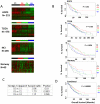Deregulation of MYCN, LIN28B and LET7 in a molecular subtype of aggressive high-grade serous ovarian cancers
- PMID: 21533284
- PMCID: PMC3076323
- DOI: 10.1371/journal.pone.0018064
Deregulation of MYCN, LIN28B and LET7 in a molecular subtype of aggressive high-grade serous ovarian cancers
Abstract
Molecular subtypes of serous ovarian cancer have been recently described. Using data from independent datasets including over 900 primary tumour samples, we show that deregulation of the Let-7 pathway is specifically associated with the C5 molecular subtype of serous ovarian cancer. DNA copy number and gene expression of HMGA2, alleles of Let-7, LIN28, LIN28B, MYC, MYCN, DICER1, and RNASEN were measured using microarray and quantitative reverse transcriptase PCR. Immunohistochemistry was performed on 127 samples using tissue microarrays and anti-HMGA2 antibodies. Fluorescence in situ hybridisation of bacterial artificial chromosomes hybridized to 239 ovarian tumours was used to measure translocation at the LIN28B locus. Short interfering RNA knockdown in ovarian cell lines was used to test the functionality of associations observed. Four molecular subtypes (C1, C2, C4, C5) of high-grade serous ovarian cancers were robustly represented in each dataset and showed similar pattern of patient survival. We found highly specific activation of a pathway involving MYCN, LIN28B, Let-7 and HMGA2 in the C5 molecular subtype defined by MYCN amplification and over-expression, over-expression of MYCN targets including the Let-7 repressor LIN28B, loss of Let-7 expression and HMGA2 amplification and over-expression. DICER1, a known Let-7 target, and RNASEN were over-expressed in C5 tumours. We saw no evidence of translocation at the LIN28B locus in C5 tumours. The reported interaction between LIN28B and Let-7 was recapitulated by siRNA knockdown in ovarian cancer cell lines. Our results associate deregulation of MYCN and downstream targets, including Let-7 and oncofetal genes, with serous ovarian cancer. We define for the first time how elements of an oncogenic pathway, involving multiple genes that contribute to stem cell renewal, is specifically altered in a molecular subtype of serous ovarian cancer. By defining the drivers of a molecular subtype of serous ovarian cancers we provide a novel strategy for targeted therapeutic intervention.
Conflict of interest statement
Figures




References
-
- Bookman MA. Trials with impact on clinical management: first line. Int J Gynecol Cancer. 2009;19(Suppl 2):S55–62. - PubMed
-
- Edwards SL, Brough R, Lord CJ, Natrajan R, Vatcheva R, et al. Resistance to therapy caused by intragenic deletion in BRCA2. Nature. 2008;451:1111–1115. - PubMed
-
- Fong PC, Boss DS, Yap TA, Tutt A, Wu P, et al. Inhibition of poly(ADP-ribose) polymerase in tumors from BRCA mutation carriers. N Engl J Med. 2009;361:123–134. - PubMed
-
- Tothill RW, Tinker AV, George J, Brown R, Fox SB, et al. Novel molecular subtypes of serous and endometrioid ovarian cancer linked to clinical outcome. Clin Cancer Res. 2008;14:5198–5208. - PubMed
Publication types
MeSH terms
Substances
LinkOut - more resources
Full Text Sources
Other Literature Sources
Medical
Research Materials
Miscellaneous

